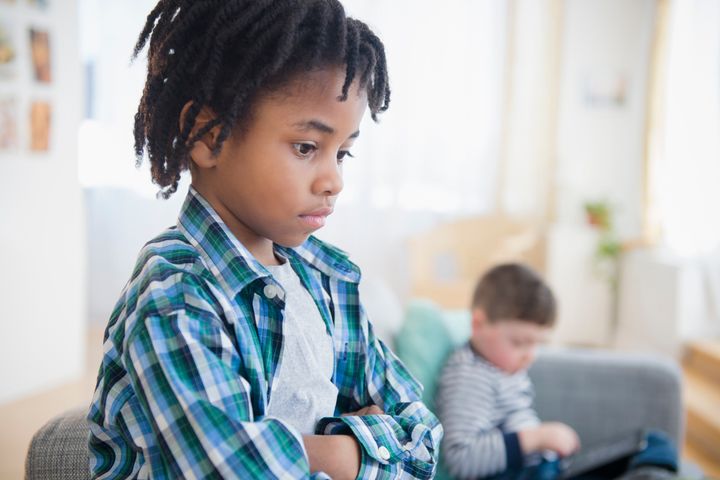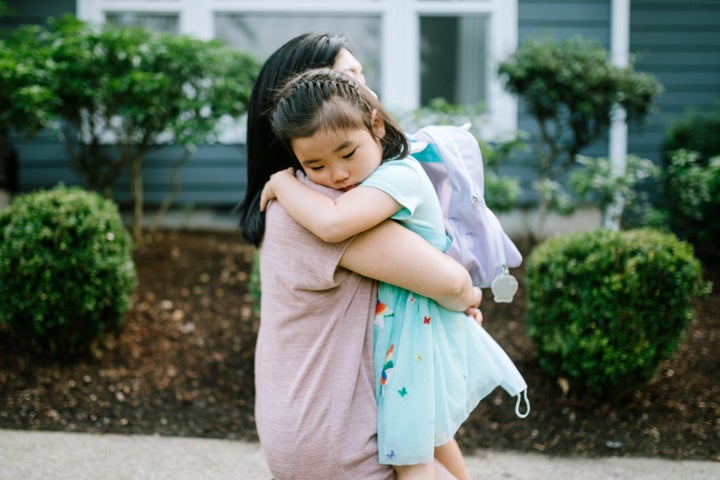The coronavirus pandemic has presented countless challenges to children from an academic, social and mental health perspective. But the shift back into more “normal” ways of life can also be difficult for kids.
Of course, we’re not exactly in a post-pandemic world (especially for children younger than 12 who have yet to gain access to any Covid-19 vaccines) as concerns rise about case counts and highly contagious variants.
But there’s no doubt things seem different this summer with travel and back-to-school preparations in full swing. And even these positive changes can be challenging and anxiety-provoking.
“Children thrive with consistency, and consistency has gone out of the window over the past year,” licensed clinical social worker Nidhi Tewari told HuffPost. “Many kids became accustomed to attending virtual school and limiting in-person contact, so it’s understandable that there may be increases in anxiety as we ‘return to normal.’”
And in the midst of this new transition, children – like adults – are also still processing the trauma of the past year and a half.

“After any disaster or traumatic experience, while the wish and hope is for a rapid return to ‘normal,’ the psychological and emotional aftermath greatly exceeds the more defined boundaries of the trauma itself,” said Dr. Ilisse Perlmutter, director of child and adolescent psychiatry at Talkiatry in New York City.
“Children’s reactions may appear immediately… or may not appear for days, weeks, even years. We also need to remember that innumerable children and adolescents lost parents, grandparents and other loved ones during this pandemic. The resulting grief and anxiety can take many forms, and recovery, or moving forward from these losses, is not necessarily correlated with a return to life as it was before.”
If we’ve learned anything from this experience, it’s that “normal” is relative.
″‘Normal’ looked at neurologically and behaviourally, is what we have experienced for the past couple of months (on a rolling basis),” said psychotherapist Noel McDermott.
“We normalise as we go along, so normal is not what happened 18 months ago pre-pandemic. Normal is the last three months generally. So currently we are not transitioning back to normal; we are transitioning out of the normal we have been in for the last few months into a new normal. Transitions of our life circumstances are always potentially anxiety-provoking.”
Signs of reemergence anxiety will vary depending on the child’s personality, but parents and other trusted adults can look for shifts in behaviour as indications of potential anxiety. But what kinds of behaviours should they look out for? Below, Tewari, Perlmutter, McDermott and other experts share some expected signs of “post-pandemic” anxiety in children.
Fear of separation
With so many adults working from home and students engaging in remote or hybrid learning throughout the pandemic, children have unsurprisingly formed strong attachments to their families, which may lead to separation anxiety as life outside the home resumes.
“Many kids have been attached to their parents’ sides for the past 18 months,” said Dr.Dyan Hes, founder of Gramercy Pediatrics in New York City. “Now all of a sudden parents have to return to the real world or some semblance of it. This will require sending kids to day care, a babysitter or school. Overnight a child will go from being with their parents 24/7 to being with lots of strangers. This can be extremely anxiety-provoking for even the most resilient child.”
Through her work, she said she’s observed more fear of separation in children than she did before the pandemic.
“Children who come to my office do not want to leave their parent’s hip. They scream when a stranger, like a nurse, approaches,” she said. “Other school-aged kids are having a huge amount of separation anxiety when they have to leave for camp or school.”
“You may notice that your child starts to withdraw or avoids experiences that make them anxious.”
- Nidhi Tewari, clinical social worker
It’s important to keep in mind that this clinginess is expected and appropriate, noted Jacqueline P. Wight, director of mental health services at DotCom Therapy. Plenty of adults have experienced similar emotions around returning to work and socialising. It may also be helpful to examine the concerns behind the separation anxiety to develop coping mechanisms.
“This is a natural response to the recent circumstances that will require extra sensitivity as the child begins to practice developmentally appropriate separation from a parent,” Wight said. “Some children may have preferred being home with their immediate family and are overwhelmed by the idea of returning to school or being around a group of children. This concern might be related to anxiety about being in a social situation, or it could be related to fear of illness and concern that being outside of the home is unsafe. It can feel unpredictable and outside of the child’s control.”
Withdrawal and avoidance
Other natural signs of anxiety that may emerge are withdrawal and avoidance.
That extra sense of attachment or clinginess in kids with regard to their families often goes hand-in-hand with a detachment from their friends and other factors outside the home. Children may show a lack of interest in activities they once enjoyed.
“You may notice that your child starts to withdraw or avoids experiences that make them anxious,” Tewari said. “Some children may be worried about their social skills, like being able to socialise with friends and carry conversations face-to-face. They don’t want to feel judged or out of place, so they may try to avoid social gatherings.”
Nervousness and worry
An increase in nervousness and worry is another expected manifestation of post-pandemic anxiety. Kids may be feeling a general sense of doom or an inability to relax.
“Multiple stressors – illness, death of loved ones, fear of infection, income insecurity, closure of in-person school and activities, lack of child care, reduced access to community resources – have severely disrupted daily life for children and families,” said Dr Helen Egger, a child psychiatrist and co-founder of Little Otter in San Francisco. “As we emerge from the pandemic to a new normal, children are facing ongoing stress and uncertainty about the return to school (Will we wear masks? Will I get sick? Will school be interrupted again?), worries about being behind in school subjects, worries about seeing old friends and making new friends, and separation anxieties and fears after spending more time at home.”

Meanwhile, other children may feel very eager to return to school and in-person social interactions. These emotions can create strong feelings of anticipation, which often feels like anxiety, noted Wight. Parents can help children understand and manage worry through regular check-ins to get them comfortable talking about it.
“Helping children connect their physical experience in their body with their emotional experience is a critical skill that will benefit them long term,” Wight said. “Parents can ask their children how they are feeling in their bodies. Some examples of a child’s reply might be butterflies in the stomach, sweaty hands, fidgety legs. Then the parents can help the child connect this feeling to an emotion. So a parent might say, ‘Sometimes when I have butterflies in my stomach, I am feeling nervous about something.’”
The key is naming the emotion and normalising the experience to make it clear feelings aren’t “bad” but can be uncomfortable and challenging.
“Once the feeling is identified, then the parent and child can work together to come up with a plan for what the child can do when they are having that emotion, such as coping skills,” Wight said. “Helping children feel as though they can cope with an emotion can reduce the power that emotion might have over the child.”
Irritability and temper Issues
While we often associate anxiety with sadness, it can also lead to feelings of irritability and anger. School-aged children may be easily agitated and experience temper outbursts.
“They may become agitated and lash out when you encourage them to resume ‘normal life,’ and their reactions may seem disproportionate,” Tewari said.
As with worry and other signs of anxiety, parents can support their children by encouraging them to share their feelings, providing a safe space for honest expression and taking a calm, nonjudgmental stance, she added.
“Ask open-ended questions to deepen your understanding of your child’s anxiety triggers, and normalise your child’s worries so that they do not feel alone,” she said. “Providing children with the language to better understand their inner experience allows them to connect with what they’re feeling and communicate their feelings more effectively. Parents can use an emotions wheel with their children to help them identify and label specific emotions.”
Declining academic performance
With so many of the pandemic-related changes involving school, it wouldn’t be surprising for the anxiety around this moment to manifest in declining academic performance.
“Anxiety about the pandemic can persist, even as we move forward, and common responses from school-aged children include school refusal and performance deterioration (which in many cases was exacerbated by the necessary virtual platform) and concentration difficulties,” Perlmutter said.
“Some of my patients start to wet their pants again, some have insomnia, some vomit from anxiety.”
- Dr Dyan Hes, Gramercy Pediatrics
Tewari noted that many students have concerns about returning to school and “the unique pressures of the in-person school grind.”
“For many children, the pandemic had some benefits, such as increased flexibility in their schedule and more down time at home, so the idea of going back to the way things were may feel scary,” she said.
Parents can ease this specific anxiety by talking to their child about the return to the classroom and perhaps visiting the school or meeting the teacher ahead of time.
Regressive behaviours
Another common sign of anxiety in children can be regression to younger behaviours, which has been a common phenomenon around the pandemic.
“Kids are regressing,” Hes said. “Some of my patients start to wet their pants again, some have insomnia, some vomit from anxiety. Older children can perhaps express their fears, but for the younger ones, we have to look out for these signs.”
Thumb-sucking, tantrums and clinginess are other typical regressive behaviours. One of the best things parents can do in these situations is to approach the regression without judgment. Offer comfort and reassurance rather than shame.
“Stand there and listen,” said Perlmutter. “It is critical to recognise and process our own emotional response to all of this, and to avoid passing on our own anxiety and uncertainties to the children. Create an open and supportive environment where children and teens know they can ask questions and express their worries. Answer questions honestly, using words and concepts that are geared to the children’s developmental level. Explain that the things they are experiencing and doing are often how we express our feelings of anxiety and sadness.”
Changes in eating and sleeping
“Classic signs of anxiety are issues emerging around food and appetite, or sleep,” McDermott said.
Sleeping patterns may shift – with sleep disturbances, nightmares, waking in the night and insomnia. Children may have trouble falling or staying asleep or end up sleeping more during the day.
Parents should also pay attention to changes in eating habits, including loss of appetite, fussiness around food or extra comfort eating.
“It is developmentally appropriate for children to experience some of these behaviours and emotions, but concerns begin to mount when it interferes with their lives on a daily basis and/or in significant ways,” Wight noted.
In this case, she advised exploring professional support options, as changes in sleeping and eating patterns can strongly affect a child’s ability to function and regulate their emotions. The same goes for any of the above signs of anxiety.
“Parents do not need to wait until their child’s struggle feels like a crisis,” she said. “It’s best to proactively seek support. While parents know their children best, there are qualified and thoughtful professionals that can help parents and their children navigate through challenging situations.”
